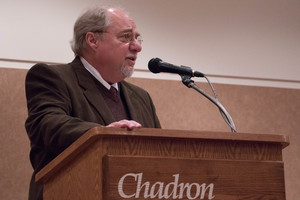Pilster Lecturer recounts Sandoz's dislike of Custer

CHADRON – In his Pilster Lecture Thursday night, Dr. Paul Hutton, a distinguished professor at University of New Mexico and five-time winner of the Western Writers of America Spur Award, reiterated Mari Sandoz’s low opinion of Gen. George Armstrong Custer with colorful excerpts from her letters.
His speech was the opening event for the Mari Sandoz Heritage Society’s annual conference at Chadron State College.
"I read Helen Winter Stauffer’s compilation of Mari’s letters to prepare for tonight. You didn't want to get on her bad side then and I don’t want to now,” Hutton said.
Sandoz’s posthumously published book, “Battle of the Little Big Horn,” is not currently the best history book about the event, but it was in 1966, according to Hutton, who discovered the book after his high school graduation in 1968 when he and friends were driving to the West Coast in a Volkswagen bus.
“It is beautifully written. It is a hallmark of pure literature and easy to read. She lived here. She experienced western life,” Hutton said. “It is weighted with death which is poignant and compelling because she was gravely ill and on her own last stand when she wrote it.”
Sandoz thought Custer was all flash and no substance, according to Hutton.
“The bottom line is: she couldn’t stand him. Her book (‘Battle of Little Big Horn’) was central to his fall as a hero and the beginning of him being viewed as an ‘Ugly American.’”
“Cheyenne Autumn,” is Sandoz’s second best book following “Crazy Horse,” in Hutton’s opinion. He said he discovered the latter book in a middle school friend’s house on the shores of Lake Michigan and was hooked on Sandoz afterward.
Although Sandoz accurately described Custer in several books, Hutton said there are exceptions to her spot-on characterizations of some historical western events. He excused them noting that, like most western writers, Sandoz believed what her Native American sources told her.
Sandoz’s remarks in “The Battle of Little Big Horn” about Custer’s vanity, ruthless ambition and insanity stand in stark contrast to the writings of Custer’s 34-year-old widow who attempted to immortalize him as a spotless knight and saintly hero, according to Hutton.
“We like myths. They give us something to believe in. We have a need for legends and heroes in our society, right? That’s the debate,” Hutton said.
Hollywood, which perpetuates many mythical figures, is notorious for bitter and brutal politics and lack of trust and authenticity, Hutton said, based on his two years of experience there. His negative view of the movie industry matches Sandoz’s.
"Even though they pilfered her classic book, Mari didn't sue the movie producers over ‘Chief Crazy Horse,’ because the movie was so bad,” Hutton said.
Hutton closed by reading an excerpt of a scathing letter she wrote to James Webb, the Academy Award winning screenwriter of “Cheyenne Autumn.”
“The characters are thoroughly drained of any qualities … Horrible … You should not have taken such liberties. Your face must burn with shame,” Sandoz wrote to Webb.
Category: Campus Events, Campus News, Sandoz Society

